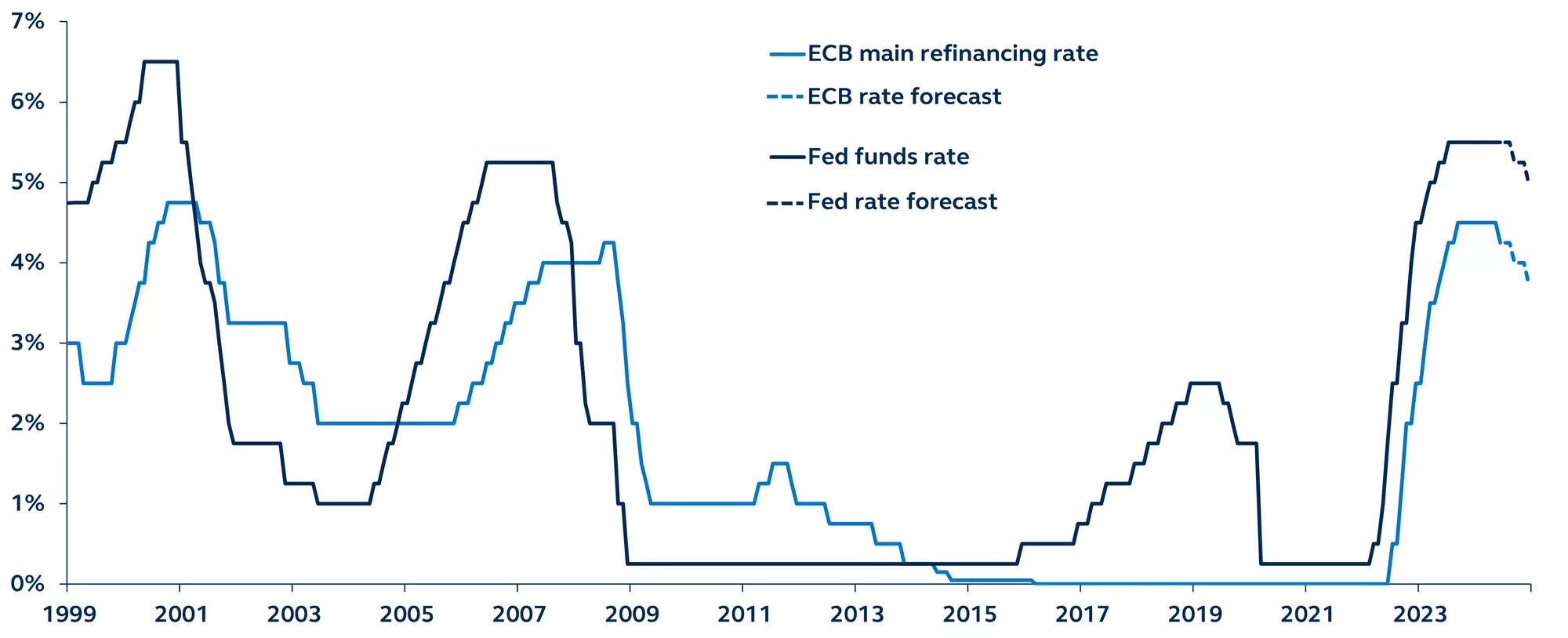The European Central Bank's 25 basis point rate cut, ahead of the Federal Reserve, underscores the differing post-COVID economic recoveries between the Euro area and the U.S. With Euro area growth lagging and inflation down from its peak, the ECB's proactive stance is warranted. However, this divergence could pressure the euro and reignite inflationary concern—expect future ECB cuts to likely align with the Fed's timeline.

ECB vs. Fed policy rate path
1991–present

On Thursday, the European Central Bank (ECB) delivered a 25 basis point policy rate cut. By contrast, the Federal Reserve (Fed) is set to keep rates on hold at its meeting this month.
Typically, central banks wait for the Fed to reduce rates before they move. In fact, until yesterday, the ECB had never cut rates ahead of the Fed. But with the Euro area experiencing a meaningfully weaker growth outcome post-COVID than the U.S., and Euro area headline inflation having plunged from a peak of 10.6% to 2.6%, the ECB had strong reason to not wait for the Fed.
Nonetheless, the ECB will be wary of its diverging policy path. A widening gap between U.S. and Euro area policy rates risks putting downward pressure on the euro, in turn adding to inflationary pressures—a dynamic the ECB must fear. Although the Euro area’s inflation fight has been impressive, recent inflation and wage data have surprised to the upside. Further euro depreciation would add to creeping concerns that Euro area disinflation may be stalling.
Some global policy coordination is required. The next ECB rate reductions are likely in September and December—the same months the Fed is likely to cut. However, if the Fed delays the start of its own easing cycle until early-2025, the ECB’s next move may be equally delayed. Higher for longer in the U.S. implies higher for longer in Europe.
Wall Street Journal Custom Content is a unit of The Wall Street Journal advertising department. The Wall Street Journal news organization was not involved in the creation of this content.
Investing involves risk, including possible loss of Principal. Past Performance does not guarantee future return.
The information presented has been derived from sources believed to be accurate; however, we do not independently verify or guarantee its accuracy or validity. Any reference to a specific investment or security does not constitute a recommendation to buy, sell, or hold such investment or security, and does not take account of any investor’s investment objectives or financial situation and should not be construed as specific investment advice, a recommendation, or be relied on in any way as a guarantee, promise, forecast or prediction of future events regarding an investment or the markets in general. The opinions and predictions expressed are subject to change without prior notice.
Principal Funds, Inc. is distributed by Principal Funds Distributor, Inc.
Securities are offered through Principal Securities, Inc., 800-547-7754, Member SIPC and/or independent broker/dealers.
Principal Asset Management leads global asset management at Principal.®
For Public Distribution in the U.S. For Institutional, Professional, Qualified and/or Wholesale Investor Use only in other permitted jurisdictions as defined by local laws and regulations.
© 2024, Principal Financial Services, Inc. Principal Asset ManagementSM is a trade name of Principal Global Investors, LLC. Principal®, Principal Financial Group®, Principal Asset Management, and Principal and the logomark design are registered trademarks and service marks of Principal Financial Services, Inc., a Principal Financial Group company, in various countries around the world and may be used only with the permission of Principal Financial Services, Inc.
3631291